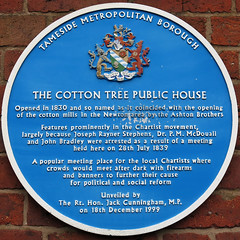Joseph Rayner Stephens


Joseph Rayner Stephens
(1805-1879)
Commemorated on 2 plaques
The Cotton Tree public house Opened in 1830 and so named as it coincided with the opening of the cotton mills in the Newton area by the Ashton Brothers. Features prominently in the Chartist movement, largely because Joseph Rayner Stephens, Dr. P. M. McDouall and John Bradley were arrested as a result of a meeting held here on 28th July 1839 A popular meeting place for the local Chartists where crowds would meet after dark with firearms and banners to further their cause for political and social reform
Cotton Tree Public House, Markham Street, Newton, Hyde, United Kingdom where they met
Joseph Rayner Stephens 1805-1879 Trained in the Ministry Joseph Rayner Stephens came to Ashton in 1832. He became an important Chartist Leader who campaigned against the Poor Law and for factory reform. His greatness was in his instinctive reaction to human distress and social injustice. In later life he lived in Stalybridge where he established a People's School and is buried in St John's Church, Dukinfield
Town Hall Frontage, Waterloo Road, Stalybridge, United Kingdom where they lived near

